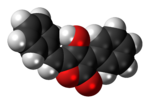Pulvinone
These hydroxylated pulvinones are produced by fungal species, such as the in Europe common Larch Bolete (Boletus elegans, also known as Suillus grevillei), or by moulds such as Aspergillus terreus.
Fungi (such as boleti), moulds and lichens produce a wide range of pigments made up of one (monomer) or several (oligomers) units of pulvinic acid.
[9] This trihydroxylated pulvinone was found as one of the main pigments responsible for the yellow colour of the stem and caps of the European mushroom Larch Bolete (Boletus elegans, also known as Suillus grevillei).
[10][11][12] To insist on their origin - and thereby differentiate them from the hydroxylated pulvinones found in Suillus grevillei - Seto and coworkers named these compounds Aspulvinones.
The fungal biosynthesis starts from aromatic aminoacids such as phenylalanine and tyrosine; after oxydeamination to the corresponding arylpyruvic acid, the pulvinone skeleton is formed by a sequence of dimerisation, oxidative ring-cleavage and decarboxylation.






